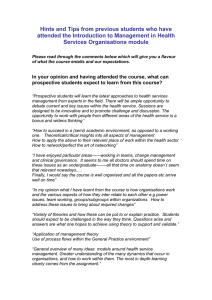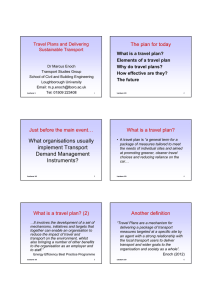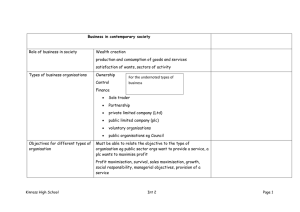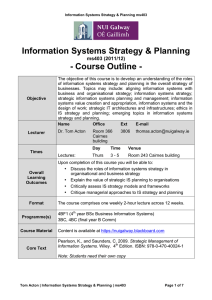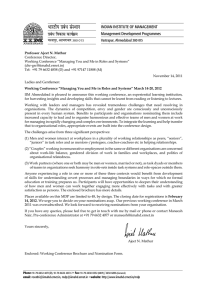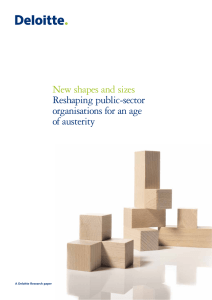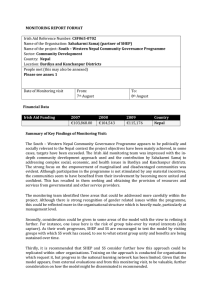Strategic planning
advertisement
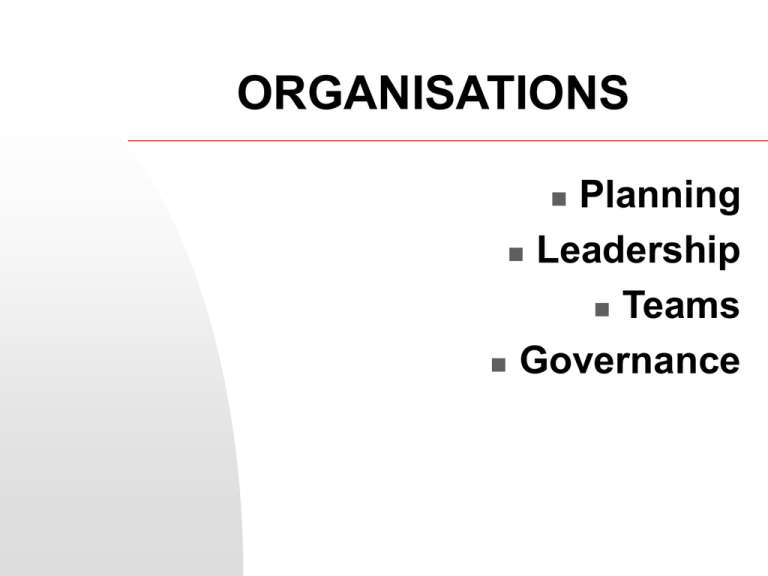
ORGANISATIONS Planning Leadership Teams Governance Strategic planning An 8-stage process Preliminaries Timing Is it the right time? Is there a Criticial timepath analysis? Organisational readiness Is there shared ownership of the strategy? Does your organisation have the the right mix of skills to achieve it? Financial stability Can your organisation sustain itself during the process? Is there a Plan B What happens if Plan A fails? Stage 1 Define the objectives What are you doing? Why are you doing it?/Who is it for? Why now? What will happen if you don’t do it? Stage 2 Generate and evaluate the options Is the strategy a ‘big bang’ approach, or is it a series of smaller actions? How will it relate to your audience or target group? Is there another way of doing it Stage 3 Identify the activities What are the components of the plan? How will each be achieved? Who will carry them out? Stage 4 Sequence the actions Prioritise the actions Why this set of priorities? What are the external factors? What are the threats? Stage 5 Identify the resources Do you have: The financial resources? The human resources? The material resources? Where are they coming from? Stage 6 Review the plan Examine the ‘big picture’ Examine any changes in external factors? Examine the detail Identify the weaknesses Consider starting over Stage 7 Prepare action plan(s) and schedules Time frames: start dates and duration Who, what and how for each action Contingencies Stage 8 Monitor and control Replan if necessary Maintain contingencies LEADERSHIP BAD LEADERS The “Bureaucrat” Can only lead “according to the book” The “ignoramus” Stubborn, closed mind refuses to accept new ideas The “hypocrite” Leaders who say “Do as I say, not as I do” The “daredevil” Over-eager, attempts everything - achieves nothing The “peacenik” Leaders who cannot permit conflict, therefore no rigour because nothing is challenged The “purist” Leaders who don’t value diversity and want to keep the team “pure” The “spaceman” So smart that no one understands what they are talking about The “softie” Sometimes the team needs to be pushed but this leader is too humane to do the pushing The “misfit” A leader with the wrong style for the job or team MORE BAD LEADERS The “self-server” Puts personal interests before the the job or team The “hermit” Leaders who don’t know their team because they are too remote The “vacillator” Inconsistency and leadership don’t mix The “hero” Leaders who say “come on, follow me”, just exhaust their staff The “nepotist” Leaders who have “favourites” The “blamer” Leaders who are more interested in blaming others than learning from their own mistakes The “alien” Leaders who are oblivious to the needs of team members The “coward” Leaders who are unwilling to fight for the team The “cinder” Passive, burnt-out leadership that can no longer generate vision for the team The “traitor” Leaders who betray the team will never recover their trust EFFECTIVE LEADERSHIP Look at the task and decides what his/her role is Acquire the knowledge to do the job effectively Brief others well to do their jobs and what the limits of their authority are Delegate decisions and responsibilities where possible Are fair and consistent Are prepared to accept criticism Help others without doing the job for them Act as resource people Make decisions where necessary without prevarication Understand how leadership operates in a group situation Are aware of and sensitive to individual needs within the group or team Leadership skillsets d People attributes Managing skills People Character Versatility Charisma Learning from listening Integrity Giving feedback Altruism Action Thinking Decision making Problem solving Initiating Making links Networking Assisting in evolution and change Merril’s behavioural profiles ANALYTICAL DRIVER Key value: Work with existing circumstances to promote quality and services Key value: Shape the environment by overcoming opposition to get immediiate results Orientation: Thinking Time: Past Orientation: Action Time: Present AMIABLE EXPRESSIVE Key value: Cooperate with others, make sure people are included and feel good about the process Key value: Shape the environment by bringing others into alliance to generate enthusiasm for the results Orientation: Relationships Time: Depends on who they are with Orientation: Intuition Time: Future How to read it Left right Passivity to assertiveness Top Bottom Controlled to emotional ANALYTICALS GOOD Perfectionists Don’t act before the time is right Reflection and rational consideration Patience Usually right BAD Critical Indecisive Moralistic Picky AMIABLES GOOD “People people”, “warm fuzzies” Understanding of relationships Great coordinators Dependable Supportive BAD Unsure Conforming Awkward Capitulators DRIVERS GOOD Action-oriented Decisive Independent Practical Efficient BAD Dominating Harsh Critical Tyrannical EXPRESSIVES GOOD Enthusiastic Future-orientated Creative Stimulating Intuitive BAD Manipulative Excitable Undisciplined Egotistical TEAMS WHAT ARE THEY GOOD FOR? Distributing and sharing Problem solving Research Evaluations, inquiries or inquests Negotiating or resolving conflict Increasing commitment and involvement Coordinating and liaising Project or programme planning Tour management Multi-cultural issues TYPES OF TEAM Project team Task force Committee Working group Heads of Department group Staff group Technical team Training team ‘Buzz’ group IT team Development team Finance and Administration team KEY DETERMINANTS OF TEAMS Size of group Individual skills of team members Resources and support provided External recognition Leadership style (who is in the chair? ) Group interaction patterns Motivation and rewards Stages of team development (Forming, storming, norming, performing 1. FORMING: When group members are just learning to deal with each other; minimal works gets done 2. STORMING: A time of stressful negotiation of the terms under which the team will work together; a trial by fire 3. NORMING Roles are accepted, Team feeling develops and information is freely shared 4. PERFORMING When optimal levels are finally reached - in productivity, quality decisionmaking, and interpersonal interdependence TYPES OF DECISION MAKING - 1 Type of decision Advantages Disadvantages CONSENSUS Innovative, creative decisions usually emerge Utilises all members of team MAJORITY RULE The team votes, majority wins . Simple. Necessary when 100% commitment is required MINORITY RULE Can be useful when the whole team cannot meet regularly Individual errors and extreme opinions tend to cancel each other out with this method Useful when the expertise of the expert is so much better than that of the team Decision by subcommittee AVERAGING True compromise EXPERT Takes a lot of time Does not suit fast moving organisations Usually leaves an alienated minority Does not utilise the talents of all team members Commitment to the decision is likely to be weak How do you know who is the best expert? TYPES OF DECISION MAKING - 2 Type of decision Advantages Disadvantages AUTHORITY RULE WITHOUT DISCUSSION Useful for simple, routine decisions Or when the team members lack the skills or information to make the decision AUTHORITY RULE WITH DISCCUSSION If done well, can gain commitment from all team members Is clear on who is ultimately responsible for the decision of the team Participative decision making 1 person cannot be a good resource for every decision Creates zero team commitment Requires good communication skills on the part of the team members Requires a leader who is willing to make decisions TEAM LEADERSHIP Myth and reality MYTH REALITY Teams require a single individual to lead them Not true. There are many models of team leadership, from iron hand to apparently leaderless. Leadership can also rotate by time or by task Strong leadership ensures success Not true. Strong leadership is useless if the people following him/her are incompetent or uninterested. A fundamentally bad team cannot be led How a leader is selected is not important Wrong. Leaders must be selected in a way that is relevant to the team task and to the team dynamics Team structure is a secondary consideration No. Any type of team structure or configuration is valid as long as it is the right team for the right task A good leader and a good team can solve any task No, not every task is appropriate for team action. If a task should not be done by a team then it doesn’t matter how skilled the team or leader is. “When your only tool is a hammer, every problem looks like a nail” Structures & governance Sources of organisational power POSITION Power based on a person’s role or job title. Know what your own is and don’t try to exceed it RESOURCE Power based on control over money, materials etc EXPERT Most common are technical and cultural expertise and process knowledge (knowing how to get things done) ARTISTIC Power based on the artistic control one person has over an organisation. PERSONAL Power based on a person’s personality or charisma INFORMATION Having unique access to information produces a power base. The more people need the information you have, the greater is your power DELEGATED Some people have been delegated power for a particular task or project. Use it wisely Types of structure Pyramids ‘Hub & spoke’ Network Cooperatives BOARDS Usually a legal requirement Think about composition carefully don’t appoint friends Balance of expertise Explain what is required of them and their legal responsibilities Be careful of ‘Advisory Boards’ and similar structures that have no legal status Have an induction session - share the vision Organisations MYTHS REALITIES It is impossible for some organisations to change because they are so large and well-established Look at changes in public sector institutions, banks and other sectors due to privatisation and IT Qualifications are forever The current trend is for continous professional development (CPD) and updating, not a dependency on degrees or out-of-date qualifications It is a good sign when you can see your future in an organisation The only organisations where you can map your future are so stable as to be stagnant and likely to close! Success means getting to the top Success today is about self-development and selfactualisation - whether or not you reach the post of Director Virtue and achievment will always be recognised in the end More and more institutions and cultural organisations are ‘buying in’ expertise from the outside, bringing with them new ideas and approaches - as well as costing little in training An internal promotion or upwards move is always a good thing Organisations today have flatter hierarchies, and a sideways move is sometimes more valuable for the individual It’s all over when you are 50 Those people with a wealth of experience are doing well because they are self-employed consultants because of the practice of ‘contracting out ‘ all but ‘core’ activities BASIC PRINCIPLE OF NETWORKS Networks are created when people come together to share common objectives or goals They are generally created spontaneously and evolve ‘organically’ rather than through a predetermined strategy They change over time They have minimum rules and organisational structure They promote cooperation, action and exchange across regions, States and international borders They enable models of good practice and latest innovations to be shared They create diversity and adaptability They can stimulate employment They assist in understanding cultural differences WHAT CAN NETWORKS DO? Help create partners and the sharing of costs Initiate new means of cultural cooperation across borders Raise public awareness and understanding of the sector Create new sources of funding Influence policy at a regional,national and international level Generate action, projects and change Help to change patterns of distribution and promotion Increase sectoral participation Assist in combatting aggressive nationalism, xenophobia and racism Help changes in patterns of distribution and promotion CONSTITUENCIES Define them! Who are you doing it for. • Eg:Shareholders • Stakeholders • Audience(s) • Public • Special groups BUILDING RENOVATIONS UP TO PLANNING STAGE vision document mission statement agree core functions outline spatial planning business modelling Planning permissions BUILDING RENOVATIONS POST PLANNING STAGE architectural brief selection of architects design stage drawings quantity surveyor/ Stuctural/mechanican eng final costings awarding of contracts construction/renovation opening








